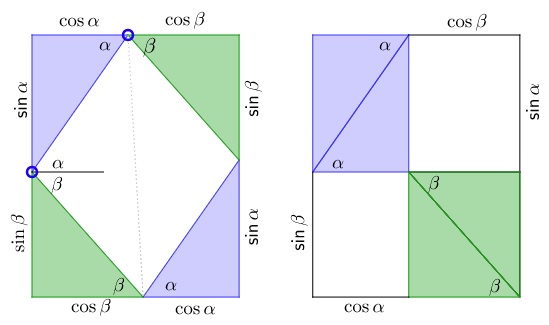Sine of the Sum Formula
The applet below illustrates a proof without words of the "sine of the sum" formula due to Volker Priebe and Edgar A. Ramos [Nelsen, p. 40].
The rhombus inscribed into a rectangle has side length of $1.$ The rhombus cuts off of the rectangle two pairs of equal right triangles. The acute angles of the triangles are $\alpha,$ $90^{\circ} -\alpha,$ $\beta,$ $90^{\circ} - \beta.$ The vertices of the rhombus split the sides of the rectangle into segments of lengths $\cos\alpha,$ $\sin\alpha,$ $\cos\beta,$ $\sin\beta,$ as shown.

The area of the rhombus is $\sin(\alpha + \beta).$ In the right half of the applet, the triangles rearranged leaving two rectangles unoccupied. The area of one is $\sin\alpha \times \cos\beta,$ that of the other $\cos\alpha \times \sin\beta,$ proving the "sine of the sum" formula
$\sin(\alpha + \beta) = \sin\alpha \cos\beta + \cos\alpha \sin\beta.$
References
- R. B. Nelsen, Proofs Without Words II, MAA, 2000
Trigonometry
- What Is Trigonometry?
- Addition and Subtraction Formulas for Sine and Cosine
- The Law of Cosines (Cosine Rule)
- Cosine of 36 degrees
- Tangent of 22.5o - Proof Wthout Words
- Sine and Cosine of 15 Degrees Angle
- Sine, Cosine, and Ptolemy's Theorem
- arctan(1) + arctan(2) + arctan(3) = π
- Trigonometry by Watching
- arctan(1/2) + arctan(1/3) = arctan(1)
- Morley's Miracle
- Napoleon's Theorem
- A Trigonometric Solution to a Difficult Sangaku Problem
- Trigonometric Form of Complex Numbers
- Derivatives of Sine and Cosine
- ΔABC is right iff sin²A + sin²B + sin²C = 2
- Advanced Identities
- Hunting Right Angles
- Point on Bisector in Right Angle
- Trigonometric Identities with Arctangents
- The Concurrency of the Altitudes in a Triangle - Trigonometric Proof
- Butterfly Trigonometry
- Binet's Formula with Cosines
- Another Face and Proof of a Trigonometric Identity
- cos/sin inequality
- On the Intersection of kx and |sin(x)|
- Cevians And Semicircles
- Double and Half Angle Formulas
- A Nice Trig Formula
- Another Golden Ratio in Semicircle
- Leo Giugiuc's Trigonometric Lemma
- Another Property of Points on Incircle
- Much from Little
- The Law of Cosines and the Law of Sines Are Equivalent
- Wonderful Trigonometry In Equilateral Triangle
- A Trigonometric Observation in Right Triangle
- A Quick Proof of cos(pi/7)cos(2.pi/7)cos(3.pi/7)=1/8
Proofs Without Words
- Proofs Without Words
- Sums of Geometric Series - Proofs Without Words
- Sine of the Sum Formula
- Parallelogram Law: A PWW
- Parallelogram Law
- Ceva's Theorem: Proof Without Words
- Viviani's Theorem
- A Property of Rhombi
- Triangular Numbers in a Square
- PWW: How Geometry Helps Algebra
- Varignon's Theorem, Proof Without Words
|Activities| |Contact| |Front page| |Contents| |Algebra|
Copyright © 1996-2018 Alexander Bogomolny73586121
